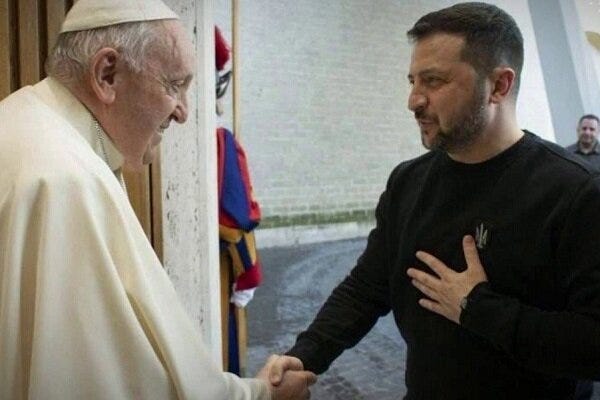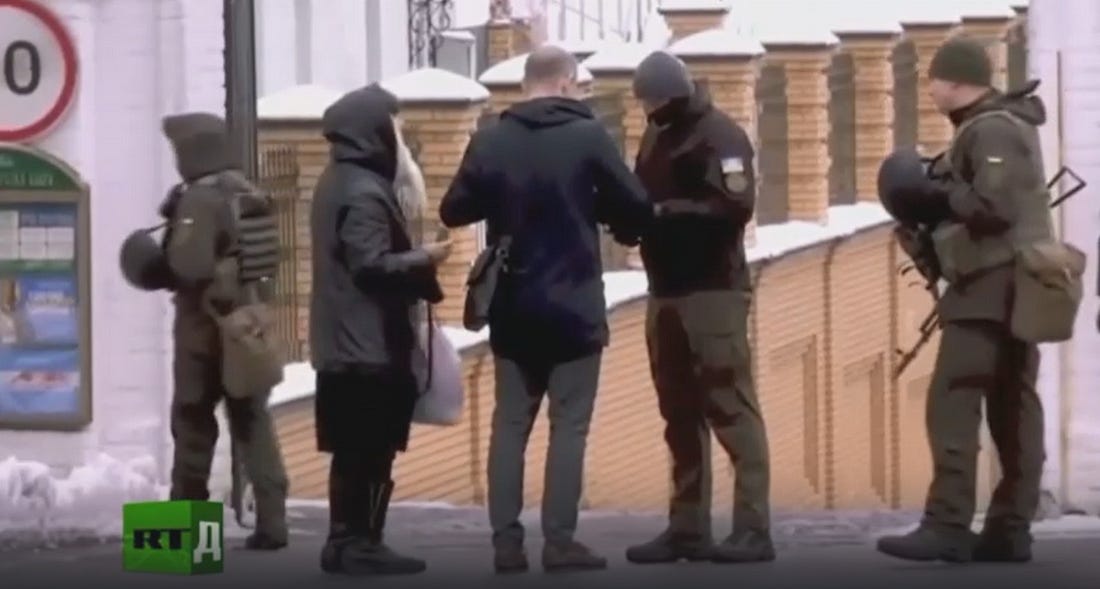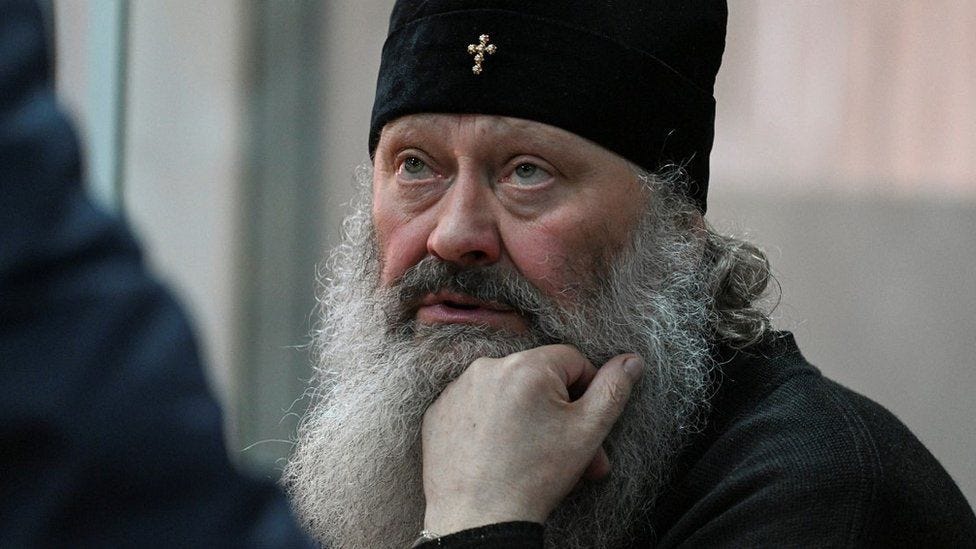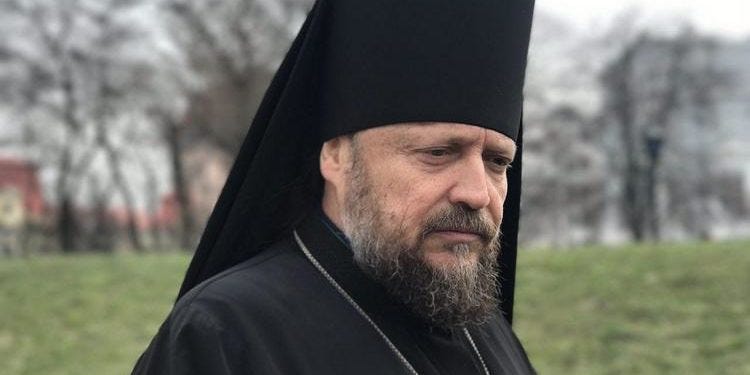Zelensky Wears Nazi Symbol While Meeting with Pope
Meeting takes place amid unprecedented persecution of Orthodox believers in Ukraine

Pope Francis, supporting himself with a walking stick, greeted Ukrainian President Volodymyr Zelensky in the Vatican audience hall, before the two began their May 13th visit in a nearby papal studio.
Zelensky placed his hand over his heart, next to the trident symbol on his sweatshirt, and said it was a “great honor” to meet with the pope. The symbol was originally used by the OUN, the Organization of Ukrainian Nationalists, who collaborated with the Nazis during WW2. It is often depicted with a yellow trident against a background of blue. Don’t take my word for it though, here is the image of it from Wikipedia, where its origins are conveniently documented for all to see.

The two sat down at a table where they met for 40 minutes. After his audience with the pope, Zelensky tweeted his gratitude for the meeting, and thanked the pope for his “personal attention to the tragedy of millions of Ukrainians.”
During the short meeting, however, it’s unlikely that they talked much about the growing persecution of Orthodox Christians in Ukraine.
Just the day before Zelensky met with Pope Francis, an Arria formula meeting of the UN Security Council was held, concerning the escalating abuse of members of the Ukrainian Orthodox Church (UOC) and its clergy, which violates international agreements on human rights. You can watch the entire UNSC meeting here with English voice-over.
Vasily Nebenzya, Permanent Representative of Russia to the United Nations and the UN Security Council, said that the meeting was convened “to draw attention to an unprecedented situation: The canonical Ukrainian Orthodox Church, which is a traditional church with centuries of history and millions of worshipers, is teetering on the edge of a legislative ban.”
Nebenzya voiced concerns for the churches themselves, which he said are under threat of seizure, and for its clergy, which “lives under constant fear of reprisals.”
According to the Russian diplomat, as of March, 2023, there have been 81 decisions by local governments in Ukraine to “ban” the activities of the UOC and since 2022, more than 300 cases of the seizure of church property have been documented. Nebenzya added that in Ukraine, 61 criminal cases have been opened against the clergy of the UOC, and that seven clerics have been arrested.
Nebenzya presented a segment from a documentary produced by Russia Today, in which agents of the SBU, the Security Service of Ukraine, are seen blocking entrances to Kiev’s oldest monastery. The agents search and question churchgoers. According to the video, they were looking for “Russian spies.”

Some churches are believed to offer refuge to those fleeing persecution by the regime in Kiev, and agents of the SBU have the authority to pronounce monks and priests “agents of Moscow,” if they have not broken off relations with the Russian Orthodox Church.
In one church, the SBU found magazines that had been printed in Russia. They were religious magazines and they were three years out-of-date, but that is all the “evidence” needed these days to arrest, imprison and even execute a person in Ukraine, according to one of the witnesses interviewed in the video.

Although Western media is full of claims that Russia is bombing churches in Ukraine, Russian media has been documenting a different story: A story about churches that are shelled by Ukrainian forces, which have routinely targeted civilian infrastructure in Eastern Ukraine, where the majority of Russian-speakers live.
According to Nebenzya, Western media ignores this growing problem and the UN’s high commissioner for human rights “will remain blind to this situation.” Without UN intervention, the diplomat said, the situation will become a catastrophe.
Mira Terada, the head of the Foundation to Battle Injustice, a Russian human-rights organization, also spoke at the Security Council, noting that the persecution against the UOC has reached levels not seen since the days of Pagan Rome.
“The abbots of churches and monasteries are abducted by the Ukrainian special services,” Terada said. “They’re tortured and kept in unbearable conditions, forcing them to renounce their faith.”
Some of the persecution, Terada said, is based on religious differences, and some of it has more to do with politics. “Orthodoxy has become a political project in the hands of the Ukrainian regime,” she said, adding that these attacks on churchgoers began well before Russia’s Special Military Operation but took on “catastrophic proportions” after Russia crossed the border on February 24, 2022.
“In less than a year,” Terada said, “about a hundred religious sites in the area of the Special Military Operation were subjected to various kinds of repression by the Ukrainian government.”
That repression, Terada said, included the looting and destruction of churches and monasteries as well as the beating and torture of clergy who are imprisoned in inhumane conditions and sometimes forced to speak out against the UOC. Some are even stripped of their Ukrainian citizenship.
In January, 2023, Terada said, Ukrainian prosecutors opened criminal proceedings against Metropolitan Pavel Lebed, the rector of the Kiev-Pechersk Lavra, accusing him of “inciting religious hatred.” In March, 2023, the Ministry of Culture of Ukraine unilaterally terminated the lease agreement for the lavra, which means “monastery,” and demanded that its monks leave there and join the “schismatic Orthodox Church of Ukraine” — that is, the group of churches which take direction from Kiev.

Also speaking at the UN Security Council was Gideon Makarovsky, Bishop of the Ukrainian Orthodox Church in retirement and Vicar of the Kiev Diocese.
“I could be in the Guinness Book of World Records,” Gideon said through an interpreter, “because I have been stripped of Ukrainian citizenship twice and not for any of my own political views, but for Orthodox faith.”
“The Orthodox Church today is being oppressed on the territory of Ukraine,” he continued, “through all means available, the constitution is being trampled, the law is being trampled, the law of Ukraine…all of this is being violated today.”
The Bishop explained that Orthodox churches in Ukraine are being pitted against each other, adding that “churches are being closed, clergymen are being killed or beaten, and our shrines, our Orthodox shrines, are being desecrated as well. Dogs are being taken into churches and monasteries where for centuries, if not millenia, people have been praying to God.”
Bishop Gideon, who also has US citizenship, was indeed stripped of his Ukrainian citizenship two times. The first time was during the administration of Petro Poroshenko and the second time was by decree of Zelensky. His personal information was also transferred to international law enforcement organizations and because of that, he was arrested during a visit to Athens, Greece, and placed in solitary confinement without being charged, he said.

The schism
It has been 969 years since the split between the Eastern Orthodox Christian movement and the Roman Catholic Church. Almost an entire millennium.
According to most history books, the Catholic Church and the Eastern Orthodox Church have officially been in a state of schism since the East–West Schism of 1054, and the schism was caused by language differences and doctrinal disputes between the Western and Eastern churches.
According to a well-annotated article in the Gateway Pundit, however, there is a less-known story which is closer to the truth. “Within 200 years of the schism,” the article says, “Catholic Crusaders sacked Constantinople (now Istanbul), murdering Eastern Orthodox Christians and looting their churches…”
The article explains how in 1204, the Crusaders of the Catholic faith captured and looted Constantinople, which was at that time the capital of the Byzantine Empire and the nerve center of the Eastern Orthodox Church.
After sacking the city, the Crusaders divvied up the loot, which included most of the territories of the Byzantine Empire. The capture of Constantinople was a pivotal point in medieval history. The attack on what was then the largest Christian city in the world, was controversial and unprecedented, the article goes on. Reports of the looting and the brutality of the Crusaders shocked and horrified the Orthodox world. Afterwards, the Byzantine Empire was left shrunken and impoverished and less capable of defending itself against the conquests that followed.
The article concludes by criticizing the pope’s silence regarding the persecution of Eastern Orthodox Christians in Ukraine, and calls the meeting between the pope and Zelensky a “grotesque farce.”

Though most Western media played up the visit with Pope Francis, Italian media reports that the Ukrainian president refused the pope’s repeated offers for help in mediating between Kiev and Moscow.
“I have a deep respect for his Holiness,” Zelensky reportedly said to Italian media. “The thing is, we have no need for mediators.”
About the author:
Deborah Armstrong currently writes about geopolitics with an emphasis on Russia. She previously worked in local TV news in the United States where she won two regional Emmy Awards. In the early 1990’s, Deborah lived in the Soviet Union during its final days and worked as a television consultant at Leningrad Television. You can support Deborah’s writing at Paypal or Patreon, or donate via Substack.




If Ukraine has no need for mediators, why did he visit the Pope then? The Vatican cannot supply him with more missiles. Rhetorical question of course, it was all just a media stunt. Shame on his Holiness to allow himself to be exploited in such a fashion, smh
Great article Deborah! You correctly showed how the whole meeting with the Pope was a grotesque farce. Keep these superbly written and documented articles coming!